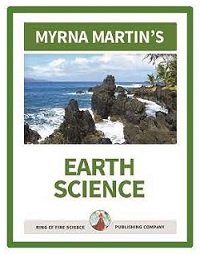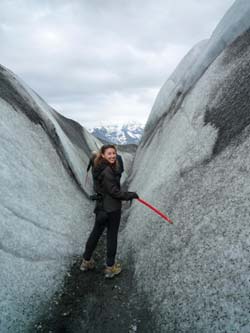The theory of plate tectonics
How and why tectonic plates move
Why crustal plates move
The Theory of Plate Tectonics explains how and why crustal plates move around the Earth. It also explains why the Pacific Ocean has so many volcanoes, large earthquakes and tsunamis. It gives us a basic understanding of how our planet is changing. It explains how mountains form, why crustal plates move and where great earthquakes are likely to occur.
Visitor to Iceland walks on an icy crevasse Sarah Masters
Plate Tectonic boundaries
Earthquake zones
Seismologists discovered earthquake zones around large blocks of the Earth's crust. Researchers found a divergent boundary formed when crustal plates separated. Divergent boundaries form the global mid-ocean ridge system which is the longest mountain chain on Earth.
Subduction zones
Convergent boundaries
Subduction zones are areas on the surface of the Earth where two tectonic plates come together. Scientists discovered a convergent boundary formed between the crustal plates as they converged forming a subduction zone. Scientists also discovered ocean trenches separated the two plates on the ocean floor at convergent boundaries in subduction zones.

Our Earthquakes textbook contains sixteen chapter. Each chapter includes a lesson, quiz and activities about how and where earthquakes occur. Chapters include information about earthquake faults, seismic waves, Mercalli scale, and tsunamis. Myrna

Click for More Information and to Order
the Pacific Plate and Nazca Plate
Pacific Plate converging with other plates
The Pacific Plate contains the largest ocean on Earth. Crustal plates are converging on the Pacific Plate creating subduction zones where great earthquakes occur. The Nazca Plate and Pacific Plate are converging.
1960 Chilean earthquake largest ever recorded
The largest earthquake in the 20th occurred with the two plate converged off the coast of Chile. The earthquake's epicenter of the magnitude 9.5 earthquake occurred in the subduction zone where the two plates broke along the fault line.
Mid-Atlantic Ridge
Iceland on the Mid-Atlantic Ridge
The Mid-Atlantic Ridge is a mid-ocean ridge that runs down the middle of the Atlantic Ocean. Plate movements along the ridge produce small earthquakes that produce P waves and S waves as basalt lava pours out of fissures on the ocean floor. Iceland sits on the Mid-Atlantic Ridge over a hot spot. The picture above shows a rift valley that formed above sea level on Iceland. It is one of the few places on Earth people can view activity on the Mid-Atlantic Ridge.
Plates on both sides of the Mid-Atlantic Ridge
Most of the Mid-Atlantic Ridge is found deep at great depths on the seafloor. The North American Plate and the Eurasian Plate are moving apart in the North Atlantic Ocean. The African Plate and the South American Plate are separating in the Southern Atlantic Ocean.
KIDS FUN Science Bookstore
Check out Myrna Martin's award winning textbooks, e-books, videos and rock sets. The Kids Fun Science Bookstore covers a wide range of earth science topics. Click here to browse.











